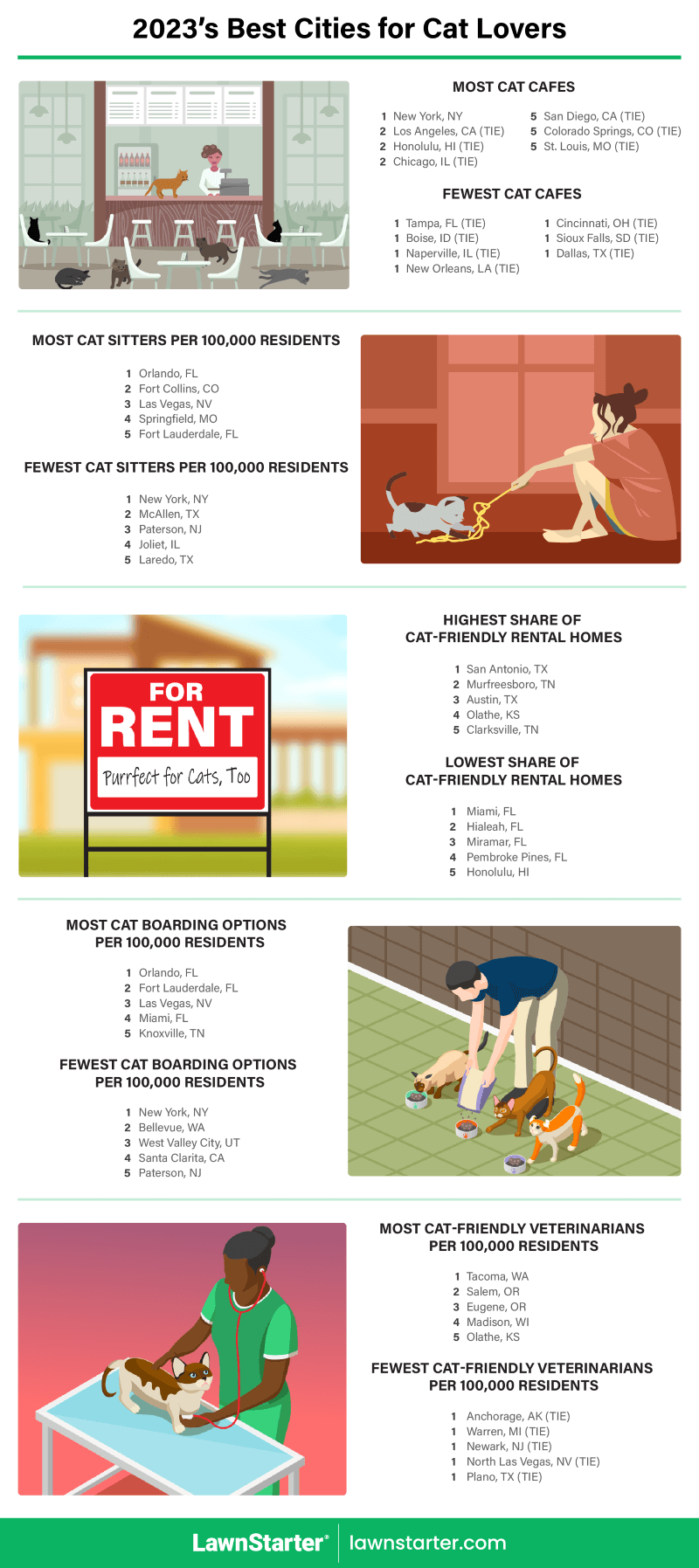
Which cities are purrfect for ailurophiles and their furry, biscuit-making companions?
To mark International Cat Day on Aug. 8, LawnStarter ranked 2023’s Best Cities for Cat Lovers.
We compared the 200 biggest U.S. cities based on four categories. We looked at access to animal shelters, vets, and cat-friendly housing. We also factored in affordability, among 15 indicators of feline-friendliness.
Claw through our ranking below. To learn how we ranked the cities, see our methodology.
Contents
- City Rankings + Infographic
- Top 5 Close Up
- Key Insights
- Ask the Experts
- Behind the Ranking
- Happy Cat = Happy Home
City Rankings + Infographic
See how each city fared in our ranking:

Top 5 Close Up
Check out the slideshow below for highlights on each of our top five cities.
Key Insights
The Gist
The Southern half of the U.S. is the cat’s meow for our feline friends. Nearly three-quarters of our top 20 cities come from this region — possibly more depending on where you draw the line between Northern and Southern states. Most of the cities in this elite group — spanning California to Florida — ranked particularly well in both Cat Access and Care Access.
At the opposite end of our ranking are a mix of Northern and Southern cities, with Detroit once again in last place. Motor City earned nearly five more points since 2022, but the improvements barely scratched the surface in any category. Our bottom cities collectively earned some of the worst scores across all categories — with some exceptions.
Standout Stats
Orlando Magic
- A certain mouse better watch out — Orlando, Florida, is our Cat Lovers Capital for the 2nd year in a row. O-Town leads by over 10 points ahead of silver medalist Knoxville, Tennessee — up from six points in 2022 ahead of this year’s 7th placer, Scottsdale, Arizona.
Spoiled in the Sunshine State
- Florida’s felines will feel least neglected when visiting the state. Florida cities like Orlando (No. 1), Miami (No. 14), and Fort Lauderdale (No. 13) make up half of our top 10 for Care Access. This impressive group performance comes down to high scores in three metrics: cat sitters, cat boarding options, and pet stores.
No Cats Allowed
- Although cats vacationing with their owners in Florida will have no problem finding a temporary place to stay, it’s a different story for local felines. Sunshine State cities make up six of the 10 worst in Housing and Accommodations.
Nosedivers
- Among the 10 cities that fell furthest overall in our ranking this year, four managed to remain in the top 50%. They include Olathe, Kansas (No. 57), Frisco, Texas (No. 67), Naperville, Illinois (No. 78), and Chattanooga, Tennessee (No. 96).
Contradictory Costs
- Nine of the 10 most affordable cities for cat owners are in California — the 2nd most expensive U.S. state. Surprised? The average household income in the Golden State is the 6th highest in the nation. So, despite high cost of living and inflation, many residents are able to splurge on their kitties.
Stray Cats Strut
- You’ll have a hard time finding cats to adopt or play with in 11 cities that tied for last place in Cat Access. Miramar, Florida (No. 199), Paterson, New Jersey (No. 196), Sunnyvale, California (No. 158), and Olathe, Kansas (No. 57), are among the cities lacking animal shelters and cat cafes.
Last But Not Least
- Two New Jersey cities stood out among the 10 worst cities — for good reasons. Paterson (5th worst overall), is more affordable than 153 other big cities, while Newark (7th worst) outranked 140 cities in Housing and Accommodations.
Ask The Experts
Cats are known for being pretty easygoing, but there are still many ways that human butlers can optimize their kitty’s comfort.
We turned to a panel of experts to find out how to keep our feline friends feeling fine. Explore their insights below.
- What are the top three items cat owners should have in their homes for their cats’ enrichment?
- What are the most common signs of illness in cats that owners should look out for?
- Do you recommend letting pet cats roam outdoors? Why or why not?
- How much exercise do cats need in a day? What’s the best way to make sure they get enough exercise?
- What does a healthy diet look like for a strictly indoor cat?





What are the top three items cat owners should have in their homes for their cats’ enrichment?
1. A cat tree
2. A fishing pole-type toy
3. Cat grass
What are the most common signs of illness in cats that owners should look out for?
Loss of appetite and failure to groom. Urinating out of the box is common if the cat has a urinary tract problem.
Do you recommend letting pet cats roam outdoors? Why or why not?
No, the cat is in dander of disease and predation by coyotes, dogs, or raptors. In addition, the birds are in danger from the cat.
How much exercise do cats need in a day? What’s the best way to make sure they get enough exercise?
There is no 10,000-step recommendation for cats. Exercise is more important than enrichment — that is, playing.
What does a healthy diet look like for a strictly indoor cat?
A healthy diet should include both wet and dry food. The former assures that the cat is hydrated. The large pet food companies Purina Hills Royal Canin test their food on cats so they can guarantee that they are safe. Avoid trendy no-grain, raw, or boutique diets.

What are the top three items cat owners should have in their homes for their cats’ enrichment?
1. Laser pointer
2. Scratching posts
3. Food puzzles
What are the most common signs of illness in cats that owners should look out for?
Decreased or increased appetite, vomiting, diarrhea, weight loss, a change in water consumption, and/or an increase or decrease in activity level should prompt a visit to the veterinarian.
Do you recommend letting pet cats roam outdoors? Why or why not?
While time outdoors can be beneficial for cats’ mental and physical health, outdoor cats are much more likely to contract contagious diseases, be hit by cars, or be injured by altercations with other cats or animals.
A good compromise is an enclosed outdoor area (commonly referred to as a “catio”), where cats can enjoy time outdoors while also being protected from some of the aforementioned risks.
How much exercise do cats need in a day? What’s the best way to make sure they get enough exercise?
There is no specific time allotment for feline daily exercise. Like in humans, exercise provides many mental and physical benefits for cats.
If your cat is currently sedentary, start slowly with an exercise program by increasing physical activity 10-15% per week.
Some good ways to encourage physical activity are by:
- Encouraging cats to chase laser pointers (be sure to occasionally let them “catch” the light or a treat so that they don’t become frustrated);
- Playing with dangly feather or rope toys (be careful not to let them ingest anything like string, which could become lodged in their intestines); and/or
- Something as simple as encouraging them to run up and down stairs in order to get their daily meals.
What does a healthy diet look like for a strictly indoor cat?
Look for foods that are approved by AAFCO (the Association of American Feed Control Officials). This group is responsible for formulating guidelines that ensure foods meet minimum nutritional requirements for animals.
If you choose to home-cook for your cat, be sure to discuss a diet plan with a veterinary nutritionist as it is very difficult to properly balance a cat’s diet without professional help.

What are the top three items cat owners should have in their homes for their cats’ enrichment?
1. Toys — lots of them: There are a lot of interactive toys available now that can entertain them and keep them busy. Be sure they are safe-no small pieces or parts that could be swallowed and cause gastrointestinal issues.
2. Scratching posts: Give them both horizontal and vertical surfaces. Scratching posts made from cardboard and sisal rope are favorites for cats. If they are vertical, buy a tall one as they like to stretch and reach when scratching.
3. Cat trees: Cats like to be vertical and off the ground. Cat trees or wall shelves give them the opportunity to be elevated which makes them less stressed and happy especially if you have children or dogs.
What are the most common signs of illness in cats that owners should look out for?
Cats are very good at hiding their symptoms when sick. Be sure to monitor their food and water bowl to ensure they are consuming adequate food and water on a daily basis.
Monitor the litter box daily to determine that they are urinating and having normal bowel movements.
Also, keep an eye out for vomiting or any urination outside of the litter box. Cats will often hide or avoid the family when they don’t feel good, so if you aren’t seeing them hanging around like usual, there may be something wrong.
If you notice anything out of the ordinary or symptoms mentioned above, it would be worth a visit to your primary care veterinarian to assess their health.
Do you recommend letting pet cats roam outdoors? Why or why not?
While giving a cat outdoor access can be a positive enrichment experience, it can be filled with many dangers, especially if you live in a suburban area.
Of course, the biggest concern is the potential for vehicular trauma, which causes very serious injuries requiring extensive veterinary care or even death.
Other hazards include exposure to toxins, such as antifreeze; wild animals, such as coyotes or even big dogs; and exposure to the elements, such as heat and cold, which can cause significant medical issues.
To give them the outdoor experience without the hazards, consider building them a “catio,” such as these. Catios are a great way for them to enjoy the sunshine and avoid the dangers that lurk outside.
How much exercise do cats need in a day? What’s the best way to make sure they get enough exercise?
Cats are crepuscular, which means they are most active in the morning and the evening. This is when they tend to exercise the most and a time when you can engage them in play that will help burn some energy and enrich their daily life.
At least 15-30 minutes of play per day is recommended to keep your cat healthy and active. This is good time to pull out the laser pointer or the feather wand to get them moving. Not only does this give them exercise for their body, but it also exercises their mind, which is great at reducing stress and making them a happier, healthier cat.
Stress has a significant negative impact on the health of cats, so providing them ways to exercise and enrich their lives is highly beneficial.
What does a healthy diet look like for a strictly indoor cat?
A healthy diet for a cat would be feeding a good-quality, commercially available dry kibble that feeds to their life stage. For example, a kitten should eat a diet formulated for kittens, and a senior cat should eat a diet formulated for a senior.
Feeding canned food, in addition to the dry kibble, also benefits cats as they will intake more water eating canned food, which is important to help cats maintain a healthy urinary tract.
Be sure to follow the feeding guidelines or consult with your primary care veterinarian on the amount to feed as you don’t want to overfeed them, which can lead to obesity.
In addition, using a water fountain will help cats drink more water and can also be a source of enrichment for them.

What are the top three items cat owners should have in their homes for their cats’ enrichment?
Cats are designed to be amazing hunters that eat many meals of small prey daily. This requires constant surveillance of an area and the ability to hunt and capture wily prey items.
Cats are also vulnerable to becoming prey for larger hunters and territorial disputes with other cats.
To allow for natural behaviors, cats need to be able to do all of these activities: hunt, view, and hide. That means having perches and safe hiding areas for our feline friends.
- Many cat trees provide both types of these spaces, but a fancy tree is not necessary. Cats love perching in windows and hiding in boxes.
- Cats need to hunt, but that does not mean you need to have mice in the house. Playing with toys is actually a hunting activity, especially wand toys.
- Puzzle feeders are terrific for simulating hunting and giving cats the chance for problem-solving. However, there is a learning curve. Cats need to start with puzzle feeders that easily release treats, then progress to more difficult ones.
Do you recommend letting pet cats roam outdoors? Why or why not?
There are pros and cons to letting cats outdoors. Going outdoors allows for the types of activities discussed in the previous question –– hunting, hiding, and viewing.
However, outdoor cats risk catching diseases or parasites and injuries such as bite wounds or road accidents. Free roaming cats contribute to the decline in bird populations but get an unfair amount of blame. Humans are the largest cause of the decrease in birds due to habitat loss.
Being inside is safe but boring. Many indoor cats are overweight as they are inactive and may view eating as a hobby.
Enrichment is vital for indoor cats. There are some creative solutions to combine the safety of indoors with the fun of outdoors for our kitties. “Catification,” indoor cat play structures, and “catios,” enclosed outdoor areas, are wonderful.
What are the most common signs of illness in cats that owners should look out for?
Cats do not like to make it easy for their owners to know when they are ill. Many times they do not tell us until they are very sick. The best thing a cat lover can do is to watch for changes.
Signs of illness may include
- losing weight
- showing changes in appetite, drinking, or urination
- vomiting, having diarrhea, coughing, or sneezing.
If you think your cat may be ill, consult a veterinarian. If your cat is having trouble breathing or is not urinating, this is an emergency.
How much exercise do cats need in a day? What’s the best way to make sure they get enough exercise?
Cats are too smart to exercise just for the sake of exercise, but like the rest of us, benefit from activity. Playing with your cat once or twice daily is great for the cat and fun, as well.
What does a healthy diet look like for a strictly indoor cat?
There is no single diet that is ideal for all cats. Is the cat young? Old? Active? Sedentary? Are there any medical issues? All of these are important to consider. Obesity is a problem for many indoor cats, so it is important to control intake.
Most cats need about 250-300 kcal per day, but the calorie content of food is quite variable. Check labels and calculate how much of that particular diet a cat should eat. In multi-cat homes, it may be difficult to regulate how much each cat eats. Microchip-activated feeders are very handy for this.
Behind the Ranking
First, we determined the factors (metrics) that are most relevant to rank the Best Cities for Cat Lovers. We then assigned a weight to each factor based on its importance and grouped those factors into four categories: Cat Access, Care Access, Cat-Friendly Housing and Accommodations, and Affordability. The categories, factors, and their weights are listed in the table below.
For each of the 200 biggest U.S. cities, we then gathered data on each factor from the sources listed below the table.
Finally, we calculated scores (out of 100 points) for each city to determine its rank in each factor, each category, and overall. A city’s Overall Score is the average of its scores across all factors and categories. The highest Overall Score ranked “Best” (No. 1) and the lowest “Worst” (No. 200). Note: The “Worst” among individual factors may not be No. 200 due to ties.
Sources: American Animal Hospital Association, Cat Friendly Homes, CatTipper, Emergency Vet 24/7, Federal Housing Finance Agency, Meow Around, MoneyGeek.com, PetSitter.com, Petswelcome.com, Rent.com, U.S. Census Bureau, and Yelp
Happy Cat = Happy Home
Cats are famous for their napping skills, but dozing isn’t their only hobby. Just like people, cats need entertainment to keep from getting bored or depressed. A true cat lover’s home should be filled with fun cat-tivities for kitties to enjoy — without getting into trouble.
So, what do cats like to do besides sleep? Most of their favorite pastimes are inspired by instincts built into their DNA from back when their ancestors prowled the wild. But behaviors suited for the jungle don’t always translate well to a home with carpets to tear and valuables to topple.
The best way to protect your home from cat-astrophe is to build an environment where your kitty can indulge those ancient instincts in a positive way. A few examples of what that looks like:
Climbing
Cats need to climb, and they’ll find a way to do it. Give them plenty of safe spaces to climb and perch up high, such as cat trees and cat towers, and they’re much less likely to climb on your new curtains or freshly cleaned countertops.
Scratching
Scratching is another unavoidable cat behavior, but that doesn’t mean you have to live with shredded furniture. You can find scratching posts and pads in all shapes and sizes at your local pet store, and they usually aren’t very expensive.
The next time your kitty gets cat-scratch fever, they can take it out on their scratching toys instead of your sofa.
Hunting
All cats love to hunt. Outdoor cats get plenty of opportunities to stalk and pounce on squirrels, mice, and birds — but beware of fleas. Indoor cats need something to hunt, too. Their prey could be your favorite vase, goldfish, socks that always go missing — or cat toys, if you provide them.
Small balls, springs, and toy mice are perfect for hunting practice. There are even toys that roll or zoom around your house on their own so your kitty can chase them all day long.
If you love cats now, you’ll love them even more when they stop destroying your stuff. Turn your home into a kitty playground with a few affordable items, and you can have the best of both worlds: a happy, satisfied cat and a home that isn’t a total wreck.
Want a backyard where your feline friends can play? Talk to one of LawnStarter’s local landscapers about pet-safe plants, chemical-free lawn treatments, and more cat-friendly landscaping ideas.
Writing and research contributed by Jordan Ardoin
Media Resources
- High-resolution image of infographic
- High-resolution images of cities
- 2022’s Best Cities for Cat Lovers ranking results
- 2021’s Best Cities for Cat Lovers ranking results
Main Photo Credit: Shutterstock










